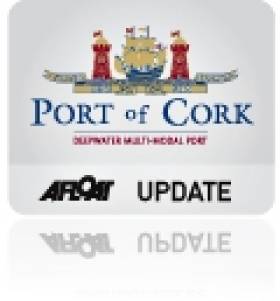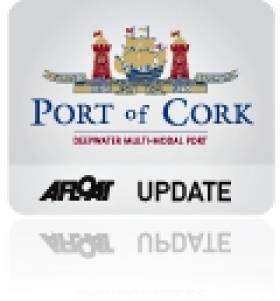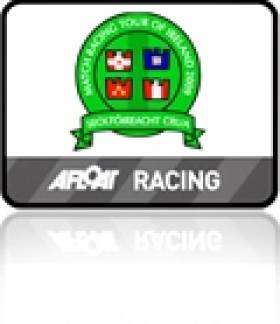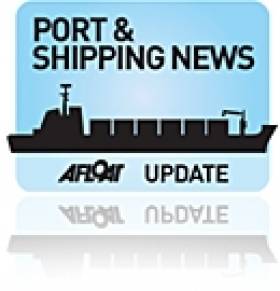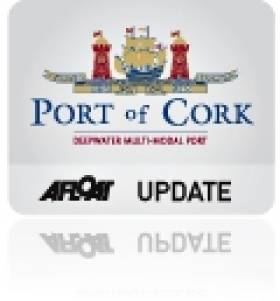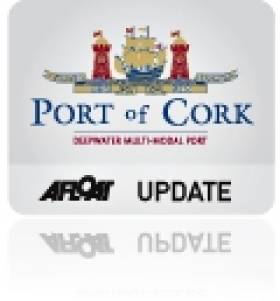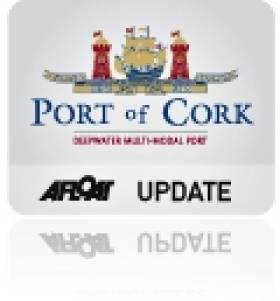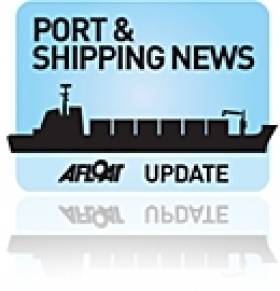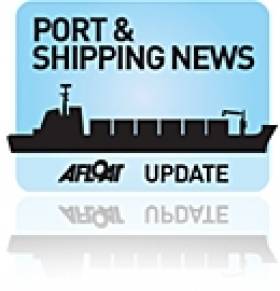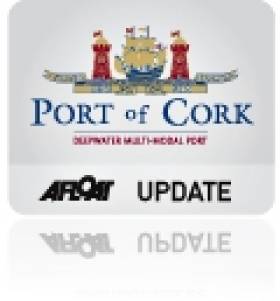Displaying items by tag: port of Cork
Port of Cork Set for Busy 2014 Cruise Season
#portofcork – Cobh Confraternity Brass and Reed Band were in Cobh today tuning up ahead of the Port of Cork’s busy cruise–liner season. The band plays on the quayside for every cruise vessel, which gives the passengers a fond farewell on the quayside and lasting memory of their visit. This year the Port of Cork will welcome 54 cruise ships to the port and despite the number of calls being slightly lower than 2013, the cruise vessels calling in 2014 are larger and have higher passenger volumes. The trend in the cruise sector is to replace smaller less efficient vessels with larger more efficient ones and in 2014 the Port of Cork anticipates 108,000 passengers and 30,000 crew will visit the Cork region.
The Port of Cork has two main objectives over the next five years, to grow the number of cruise calls and increase turn-around calls and overnight stays. The Port of Cork is also aiming to handle the new Quantum Class vessels of Royal Caribbean Cruise Lines and to this affect it is committed to investing in upgrading the current cruise facilities in Cobh. These ultra large and modern vessels carry almost 5,000 passengers and no other Port in Ireland will be able to dock these vessels, giving Cork a greater advantage when attracting new calls. Even though the cost of upgrading the current facility in Cobh is very significant, the Port of Cork is committed to the cruise sector due to its considerable financial benefit to the local economy and the Munster region in general.
Speaking about the 2014 Cruise Season, Commercial Manager at the Port of Cork, Captain Michael McCarthy said: “We have 54 cruise liners calling in 2014 which will bring another welcome boost by injecting an estimated €15 million into the local economy. Of these calls, three are maiden calls including Princess Cruise’s newest ship, MV Royal Princess, carrying 3,500 passengers. This cruise vessel is 330 metres in length (over 3 times the length of Thomond Park) and this is the size and style of ship we hope to continue to attract to Cobh. With 15 vessels of a similar size scheduled for 2015 already, the Port is committed to investing in the upgrade of our current facilities in Cobh and assessing the requirement of additional facilities as the cruise sector expands.”
He continued: “This year we also delighted to have Cunard’s Queen Victoria in Cobh and on the same day, Princess Cruise’s Ruby Princess will be in Ringaskiddy bringing a total of over 5,000 cruise passengers to the area in one day.”
MV Legend of the Seas will arrive at Cobh Cruise Berth on Saturday 26th April 2014 at 8am and will depart at 6pm.
Cork's 'Mega Port' Features In New TV3 Documentary
#PortOfCork - Have you ever wondered about the functions of the Port of Cork, the kind of people who work there, what they do and how many ships visit Cork every day and the types of cargo on board?
You can find out when you tune in to new 'fly on the wall' TV documentary series Cork Mega Port on TV3 starting Monday 28 April at 9pm.
Goldhawk Media produced the series of four hour-long episodes over four months spent living and breathing the Port of Cork.
The documentary crew followed all port employees including management, crane drivers, tug operators, pilots, launch crew and maintenance and engineering staff. Regardless of weather, they have been out on the sometimes high seas, filming the likes of Panamax-size vessels laden with cargo arriving into the port.
The series promises to give an exciting insight not just into the everyday operations of the port and the people behind it, but also highlights its importance to the region and necessity as a gateway for trade both in and out of Munster.
As well as having a serious side, the series will show the lighter side of the port by following some of the characters who have worked there for many years.
The Port of Cork prides itself on having a reliable, long-serving, experienced group of employees, and one thing that is evident within the series is the passion that exists in working at the Port of Cork.
Some staff describe working at the Port of Cork as having the "best job in the world" and from the varied services and operations that the port is involved in, it’s easy to see why.
Speaking about the new series, Port of Cork chief executive Brendan Keating said: “When we were approached by Goldhawk Media on behalf of TV3 back in 2013 and heard their experience and saw their enthusiasm, we jumped at the opportunity to get involved in this production.
"While the series shows everything the port is involved with from operations, to maintenance, the cruise business, community initiatives and our recent port redevelopment plans, it has been the level of enthusiasm from staff which has really shone through and we are very proud to share this with the people of Ireland.”
Cork Mega Port will air over four weeks on TV3 from Monday 28 April at 9pm.
Invitational 1720 Sportsboat Match Racing Event for Port of Cork
#matchrace – This Saturday the 29th Cork Institute of Technology (CIT) will be hosting an Invitational Match Racing event in aid of the Nathan Kirwan Trust in the heart of the Cork city on the River Lee. Six teams will be in attendance with University College Cork, University Limerick, Cork Institute of Technology and Baltimore and Howth Ladies all battling it, out one on one.
The event is going to be raced in 1720 Sportsboats with a crew of 5 per boat.
It will be an exciting, close matched and adrenalin-fuelled event starting at 10am alongside Kennedy Quay.
Many highly experienced sailors will be there including some who have competed in the Olympics and at National and International levels across all classes of sailing.
An exciting day of racing assured with the weather looking great for the event, any members of the public wishing to watch the event can do so from the banks of Kennedy Quay, say organisers.
#Shipping - A cargo ship captain has been fined by Cork District Cork over failing to immediately inform the Irish Coast Guard of engine difficulties suffered by his vessel late last month.
As the Irish Examiner reports, the Department of Transport, Tourism and Sport brought the case against Turkish national Mehmet Kaya, captain of the 140m Begonia G that was travelling from Foynes to the Port of Cork with its fertiliser cargo on the evening of 27 February when it lost engine power in poor weather some eight miles off Baltimore.
The court hard that the vessel began to drift towards shore, but Valentia Coast Guard was only made aware of the incident independently some two hours after it began.
Kaya's solicitor entered a guilty plea on the charge of breaching a vessel traffic directive in not informing the coastguard of his ship's loss of manoeuvrability.
The Irish Examiner has more on the story HERE.
Ringaskiddy Redevelopment Plans Go On 3D Display
#PortofCork – The Port of Cork Company today unveiled their proposed redevelopment plans for Ringaskiddy.
The proposed plans will be made available for public consultation later this week to display this key piece of strategic infrastructure which will be shown in 3D on a Real Simulated Model, highlighting the redevelopment from different aspects of the lower harbour.
The Port of Cork Company will hold three days of public consultation from 6th – 8th February to show the proposed plans for Ringaskiddy.
It is anticipated following this public consultation that the Port of Cork will lodge a planning application with An Bord Pleanala in April 2014.
The proposed developments under consideration form an extension to the existing facilities that Port of Cork currently operates at Ringaskiddy. Development is being considered in four key areas:
1. At Ringaskiddy East, where works will comprise of:
• A multi-purpose berth that will be capable of accommodating vessels carrying a range of different cargoes including containers, unaccompanied Roll On – Roll Off freight and general cargoes;
• An additional 200 metres long berth which will be used for port container traffic;
• A new container yard and marshalling area;
2. At Ringaskiddy West, where works will comprise of:
• A 180 metre extension to the existing Deepwater Berth;
• Dredging works to facilitate navigational access to the new facilities
3. At Paddy's Point, where a new public slipway is being constructed, new planting and landscaping is being provided in a new public amenity area and new pedestrian circulation routes, will be introduced.
4. Improvements to the existing road entrance at the Ringaskiddy Deep-water Terminal and internal road upgrades to improve connectivity to the remainder of the port complex and facilitate future connection to a new upgraded N28 both east and west of Ringaskiddy Village.
These proposed redevelopments are the first phase of the implementation of the Port of Cork's Strategic Development Plan Review (2010), the core principles of which were endorsed in the National Ports Policy, which highlighted Cork as a Tier 1 port of national significance.
The Policy also identified the continued commercial development of the Port of Cork Company as a key strategic objective.
As well as these proposed redevelopments, the Port of Cork is looking at a Demand Management System, which will allow the Port of Cork to control and manage the flow of unitised cargo, entering and exiting Ringaskiddy, at peak times, both in the short and longer term.
The Port of Cork is very encouraged by the NRA's recent commitment to the upgrade of the current N28 linking Ringaskiddy to Cork City. This vital piece of infrastructure will, when upgraded, improve the road network significantly.
Following the last round of non-statutory public consultation held in April 2013, the Port of Cork has taken into account, where possible, the comments from residents and communities within the harbour.
All feedback was considered and some amendments were made to the proposed plans presented at the time. The following elements were changed:
• Omission of reclamation and associated quay construction at Ringaskiddy West,
• The development area now includes the existing Ringaskiddy pier and slipway. A replacement pier, slipway and associated landscaped amenity area will now be provided at Paddy's Point.
• The upgrade of the existing road access has been changed from a roundabout to a signal controlled junction.
• Re-alignment of internal roads to tie in with the access point to the new N28
Speaking about the proposed redevelopments at Ringaskiddy Mr Denis Healy, Manager Engineering Services, Port of Cork said: "We have had constructive pre-application engagement with An Bord Pleanala to date and it is our intention to lodge a planning application in April this year. The 3D real simulation of the lower harbour, which will be on display during the public consultation, will help communities and residents to get a better picture of the redevelopment in Ringaskiddy from all aspects of the harbour."
"Our needs as a port of national significance have not changed. This European Policy positions the Port of Cork as a priority TEN-T Core Network port, the foundation blocks of which, will drive the Port to meet future connectivity needs and will support the development of the wider regional and national economy. This TEN-T funding is of key importance to the port."
Mr Healy outlined the specific drivers for this port redevelopment as;
• A Tier 1 Port of national significance which must continue the commercial development of the Port of Cork Company as a key strategic objective
• Current Navigational and Landside Constraints at Tivoli Container Terminal
• Need to Develop a New Deep-water Container Terminal capable of efficiently servicing Larger and Deeper Drafted Vessels
• Overcome Berthing and Landside Capacity Constraints at Ringaskiddy Deep-water Terminal
• Provide Certainty for all Stakeholders that Consolidated Replacement Facilities can be provided.
• Maximise the Utilisation of Existing Port Assets and Locations
• Need for Port to respond to changing Trade and Logistics Dynamics
• Flexibility to Respond to Needs as they arise in a Financially Sustainable Manner
The Port of Cork is a key link to the economic success of Ireland, in particular the entire Munster region. 98% of goods imported or exported from Ireland are moved by ship, highlighting the importance of ports to our economy.
Dates and venues for the public consultation will take place as follows:
• Thursday 6th February 2014 3-8pm – Sirius Arts Centre, Cobh
• Friday 7th February 2014 3-8pm – National Maritime College of Ireland (NMCI), Ringaskiddy
• Saturday 8th February 2014 10am – 2pm - National Maritime College of Ireland (NMCI), Ringaskiddy
Further information can be found on www.portofcork.ie
Port of Cork Trade Traffic Shows Increase in 2013
#portofcork – Total traffic through the Port of Cork in 2013 reached 9.1 million tonnes compared to 9.05 million tonnes in 2012. Like most Ports worldwide, the Port of Cork has experienced very challenging trading conditions in 2013, however some cargos have shown an increase compared to 2012 levels and this is very encouraging, according to the Port of Cork.
Container volumes through Tivoli Container Terminal were up compared to 2012 figures, and Ringaskiddy Container Terminal showed an increase in both imports and exports. This increase in Ringaskiddy is predominantly down to Fyffe's banana trade handled under contract with Maersk Line, which was established in 2012. This service, the first scheduled deep sea transatlantic service from Central America to Ireland, has opened up trading and logistic opportunities for many of Ireland's imports and exports to the Caribbean.
Oil traffic through Whitegate Oil Refinery, currently owned and operated by Phillips 66 continues to have a significant impact on the overall traffic through the Port of Cork. Imports are showing similar levels to 2012 while exports are marginally down.
Non-oil traffic has seen an increase of over 5.9% in imports of animal feed, cereal and fertiliser.
Speaking about the end of year trade traffic results, Chairman John Mullins said: "Despite challenging trading conditions worldwide, the Port of Cork saw increases in certain trades in 2013. These increases, while marginal, are encouraging and show the emergence of the economy as Ireland slowly begins to recover. Ports play a vital part in this recovery and the Port of Cork is a vital trading link to the success of Ireland and in particular the Munster region."
He continued: "The Port of Cork has achievable plans for 2014 in terms of future port infrastructure development and these plans were further endorsed in 2013 with the allocation of TEN-T funding, funding which positions the Port of Cork as a priority TEN-T Core Network port."
The Port of Cork as a Tier 1 National Strategic Port plays a key role in the movement of goods to and from European and World markets. The port secured funding as part of the TEN-T programmes which now positions the Port of Cork as a priority TEN-T Core Network port. This foundation block will drive the Port to meet future connectivity needs and supports the development of the wider regional and national economy. This TEN-T funding is of key importance to the port
The Port of Cork cruise business continues to grow year on year and 2013 was no exception. 62 cruise liners called to Cork in 2013, bringing a staggering 123,000 passengers and crew to the region. These transit visitors are a welcome economic stimulus for Cork, bringing a much needed boost to the local economy for eight months of the year. Brittany Ferries had an excellent year with their seasonal service from Cork to Roscoff carrying over 79,000 passengers in 2013. This figure is up on 2012 and there is an expectation that 2014 will be another busy year for Brittany Ferries.
Looking forward, the Port of Cork will lodge a planning application in April 2014 with An Bord Pleanála for new and improved port infrastructure in Ringaskiddy. As part of this planning proposal, the Port of Cork will engage with stakeholders to allow for feedback to be given on the proposal. The Port of Cork is confident that this planning proposal will succeed; allowing the port to enhance its competitiveness and offer improved facilities to port customers, and bring a much needed stimulus to the local economy.
Following a decision by the Department of Transport, Tourism and Sport under Minister Leo Varadkar, the responsibility of the management and control of Bantry Harbour was transferred to the Port of Cork Company on the 1st January 2014. Through its subsidiary Bantry Bay Port Company, the Port of Cork looks forward to the development of business through this port.
The Port of Cork is committed to seeking out new business opportunities for the port and in particular, the agri-food business will be a key sector which the Port of Cork is keen to develop.
John Mullins says: "The Agri sector presents huge opportunities for the port's exports, with the lifting of the Common Agriculture Policy production limits in 2015."
Another area which proved successful in 2013 and one which the port will be actively progressing, is the offshore supply services and renewable energy sector. The Port of Cork is experienced in handling large project cargo and has been at the forefront in offering services in the exploration and development needs of the various multi-national companies in this sector.
Details of sister seaport agreements between Port of Cork and PortMiami and the Port of Cork and Port of Shenzhen were announced in 2013. These seaport agreements will benefit the Port of Cork by increasing the exchange of information and ideas, with the intended aim of increasing both cargo and cruise trade between ports.
The Port of Cork Schools Initiative is now in its ninth year and aims to educate 5th class primary school children about the rich history associated with Cork Harbour and to highlight the importance of having a local port to facilitate the connectivity to world markets. The initiative also gives children a better understanding of where cargo comes from and how Ireland, as an island depends on Ports for trading. This year's theme (2014) 'Shipping Containers – Cork's Connection to World Markets' focuses on the importance of trade between Cork and the World and the important use of shipping containers for importing and exporting cargo. All participating 5th classes who take part in the Port of Cork Schools Initiative will be treated to a boat trip around Cork harbour, compliments of the Port of Cork.
The Port of Cork's recreational strategy continues to expand with the aim of improving the marine leisure facilities around Cork Harbour
Port of Cork Awarded Funding by Trans-European Transport Network
#portofcork – Following a successful funding procedure, the Port of Cork has been awarded funding by the Trans-European Transport Network (TEN-T). The Port of Cork, described as a future Core Network port by TEN-T, plays a key strategic role in the movement of goods to and from the UK and Continental Europe. This funding will assist in ensuring the Port of Cork meets future connectivity needs and will support the development of the wider regional and national economy which is of key importance to Cork.
It is anticipated that in the first quarter of 2014 and following public consultation, the Port of Cork will lodge a planning application to An Bord Pleanala for the future development of port facilities in Ringaskiddy.
The proposed developments are the first phase of the Port of Cork's Strategic Development Plan Review (2010), the core principles of which were endorsed in the National Ports Policy launched in 2013. This Policy also identified the continued commercial development of the Port of Cork Company as a key strategic objective.
Speaking about the proposed developments and the recently secured funding, Mr Denis Healy, Manager Engineering Services, Port of Cork said: "This TEN-T funding endorses the Port of Cork's plans for future development and securing connectivity for the region. The general objective of the TEN-T is to modernise transport infrastructure and this objective sits in line with the Port of Cork's need to improve and ensure future port facilities."
He continued: "The funding will go towards the achievement of the required statutory consents and the preparation of designs for developments, primarily at Ringaskiddy, but also at Marino Point and Tivoli. It also opens up the opportunity for further EU supports for the implementation phase of the project under the new Connecting Europe Facility (CEF)."
The Trans-European Transport Network Executive Agency (TEN-T EA), established by the European Commission, is responsible for managing the technical and financial implementation of the Trans-European Transport Network (TEN-T) programme, one of the most important means of infrastructure funding.
Its mission is to support the European Commission and TEN-T project managers and promoters, by ensuring the technical and financial management of the projects and the successful implementation of the TEN-T Programme.
Stricken Bulk Carrier 'Abuk Lion' Is Towed Into Cork Harbour
#AbukLion - Following the dramatic rescue of the stricken bulk carrier Abuk Lion, the Port of Cork took over the final leg of the rescue at port limits this morning, bringing the vessel inside the harbour today 31 December at 12.30pm.
Three attempts were made to attach a towline to the vessel outside the harbour in very dangerous sea conditions. However, the rescue attempt was forced to abort when the Port Authority deemed the operation too dangerous last night in gale force winds.
On the final attempt this morning, a Cork pilot boarded the vessel and co- ordinated the final towage operation with two tugs, Celtic Isle and Alex.
According to the Port of Cork, had this final attempt not been successful the vessel would have had to remain outside port limits for another two or three days, weather depending.
The tow operation was made more difficult when the Celtic Isle, skippered by Pat Stoat, was forced to tow the vessel astern due to the broken tow rope sustained in the earlier part of the rescue.
Port of Cork harbour master Capt Paul O’Regan, who coordinated the rescue from port operations, praised the skill and expertise of the Cork pilots, tug masters, boat crews and port operations who persevered with the operation in very dangerous sea conditions.
MV Abuk Lion will remain at Ringaskiddy Deepwater Berth in Cork Harbour, and the Port of Cork will ensure a berth is available until the necessary engine repairs are carried out.
Port of Cork Tug to Rendezvous with Drifting Bulk Carrier off Kinsale
#shipdrifting – A bulk carrier ship registered in Bermuda is drifting off the Old Head of Kinsale in Co Cork in strong winds and big seas.
The 108-metre vessel, Abuk Lion, is en route from Aughinish in Co Clare to St Petersburg in Russia. She is fully laden with bauxite. The vessel raised the alarm at around 3pm after its main engine failed.
The Coast Guard has sent a tug from the Port of Cork to assist the Abuk Lion. The tug is expected to rendezvous with the vessel at around 3am.
RTE News reports the Coast Guard is monitoring the situation and the Coast Guard helicopter in Waterford remains on stand-by.
Conditions at sea are bad, with Force 8 winds and swells of up to six metres. There are 13 people on board the Abuk Lion. They are not believed to be in any danger at this stage
Port of Cork Appoints New Harbour Master
#HarbourMaster-The Port of Cork Company has appointed Captain Paul O'Regan as Harbour Master, Port Operations Manager and Superintendent of Pilots of the Port of Cork. Captain O'Regan will assume the position immediately.
Commenting on this Board appointment, Mr Brendan Keating, Chief Executive said: "We are very pleased to announce the appointment of Captain Paul O'Regan as Harbour Master & Port Operations Manager in the Port of Cork Company. Paul has worked with the company for eight years and during that time he has gained considerable experience and a great understanding of the port business and he has shown excellent leadership qualities. I am confident he will be a great asset to the company in the years ahead."
Captain Paul O'Regan joined the Port of Cork in 2005 as a Pilot and then progressed to Deputy Harbour Master in 2008. Prior to this, Paul worked with a number of overseas and Irish companies.
Speaking about his appointment, Captain O'Regan said: "I am delighted to take on the role of Harbour Master and Port Operations Manager in the Port of Cork and look forward to working with my colleagues, customers and all stakeholders within the Harbour. It is an exciting time in the Port of Cork Company with its ambitious plans for the development of the port. These plans will consolidate Cork as a key seaport enabling the port to strengthen its position in global trade."
Captain Paul O'Regan takes over as Port of Cork Harbour Master from Captain Pat Farnan, who retired in January 2013.
The Port of Cork offers all six shipping modes such as; Lift on, Lift off, Roll on Roll off, Break bulk, liquid bulk, dry bulk and cruise and is Ireland's second busiest port.


























